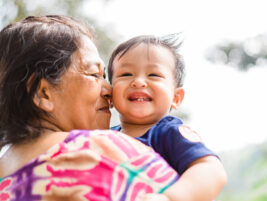Reviewed by: Deborah J. Weatherston, USA (Associate Editor, WAIMH Perspectives in IMH)
Supporting Vulnerable Babies and Young Children: Interventions for Working with Trauma, Mental Health, Illness and Other Complex Challenges
Wendy Bunston and Sarah J. Jones, Editors. UK:Jessica Kingsley, Publishers, 2020, p. 312.
This masterful collection, edited by WAIMH members, Wendy Bunston and Sarah J. Jones (Australia), is essential reading for the global community of health, mental health, early childhood and child welfare professionals. With attention to infants and very young children who face a range of challenges including serious illness, complex diagnoses, and exposure to adversity in the early years, the book offers a strong theoretical foundation, a variety of approaches and numerous case examples from around the world. Throughout, the editors and authors place an emphasis on the importance of relationships for health and healing, offering an array of strategies to promote infant and early childhood mental health.
As Bunston and Jones (2020) write in their introduction, the intent of this book is to:
“Make prominent the voice, experience and perspective of infants and young children who have endured considerable and complex vulnerabilities. This is through providing a range of expertise which brings together a disparate, contemporary and often underexamined areas of working with the world’s youngest children.” (p. 17)
Contributors to this important volume include an array of professionals from around the world – social workers, psychiatrists, community health workers, health care workers, to name a few – who give voice to this intent , e.g.: Julie Stone, Jennifer McIntosh, Christine Hill (Australia), Hisako Watanabe (Japan), Ben Gray (UK), Robyn Hemmens (South Africa), Angelique Jenney and Natasha Whitfield (Canada). Each holds infants or young children in mind, placing them at the center of interventions, respecting “salient aspects of the infants’ and families’ historical, relational, cultural and subjective experiences” and inviting those experiences “to inform our ability to create a nuanced therapeutic relationship.” (Bunston & Jones, 2020, p. 18)
What lends strength to this volume are the case studies that bring to life the complexity of experiences that very young children and their families find themselves increasing the reader’s awareness of devastation for infants in crisis as well as the possibility for the restoration of health and hope through a variety of interventions.
The titles of chapters suggest the depth and breadth of the book, e.g. Restoring Ruptured Bonds: The Young Child and Complex Traumas in Families, Keeping he Child in Mind when Thinking about Violence in Families, The ‘International Infant’: Examining the Experiences and Clinical Needs of Separated and Reunited Transnational Infant-Parent Dyads, Play With Us: Bringing Hope and Healing to KwaZulu-Natal’s Children, Infants and Young Children in the Aftermath of the Great East Japan Earthquake, Infants and Young Children Living Within High-Conflict Parental Disputes, Infants with Cancer: The Oncology Unit as their Second Home, Playing Behind the Barbed-Wire Fence: Asylum-Seeking Infants and Their Parents.
The volume gives the reader a remarkable glimpse of the state of infants, young children and their families from around the world. Although the experiences described differ, the strategies offered by contributors are solidly focused on the social and emotional needs of very young children within the context of nurturing relationships for health and healing. This book is a must read for each of us in the infant and early childhood mental health community as we struggle to reduce grave risks of disorders of infancy and support the wellbeing of all children in face of conflict and crisis.
In sum, the volume heralds an international focus on the importance of infancy as a significant period that is in reality, an urgent plea to policy makers, program developers and providers to respond with services that will hold babies and families in mind around the world. It is a valuable resource for those new as well as those more seasoned in the art of infant and early childhood mental health.
Babies in Refuge: Online resource
As a follow up to “How Refuge provides ‘refuge” to Infants: Exploring how ‘refuge’ is provided to infants entering crisis accommodation with their mothers after feeling family violence (Perspectives in Infant Mental Health, Vol 26. No. 4. Fall 2018) by Wendy Bunston (Australia), there is an online resource by Wendy Bunston and Robyn Sketchley. The online resource offers learning modules for Refuge staff to support them in thinking about the perspective of the Infant.
The Link: Refuge for babies in crisis
Authors
Reviewed by: Deborah J. Weatherston, USA
Associate Editor, WAIMH Perspectives in IMH








